High performance
and road car exhaust theory
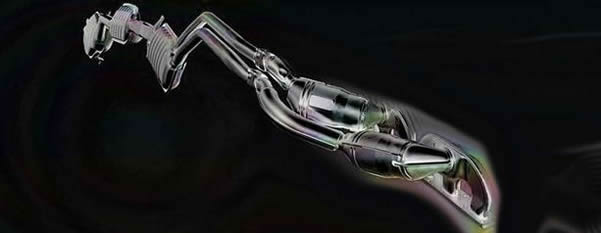
One area of car technology that has changed relatively little from outside in the last hundred years is exhaust. If you could bring back a car enthusiast from the turn of last century and have them cut open a current high performance exhaust and muffler they might see more packing and less expansion chambers - but they'd still instantly know what they are looking at. Compare that situation with carburetors and electronic fuel injection, for example and you will know what I’m talking about. It’s not all the same, far from it, but everything looks the same.
An exhaust system is usually tubing used to guide exhaust gases away engine. The entire system includes one or more exhaust pipes. Depending on the overall system design, the exhaust gas may flow through one or more tubes. Gases usually path is from cylinder head to exhaust manifold, a turbocharger if there is one, catalytic converter if there is one, muffler / silencer and trough exit tube to atmosphere. You can learn more in detail about work of Formula 1 exhaust in my article here.
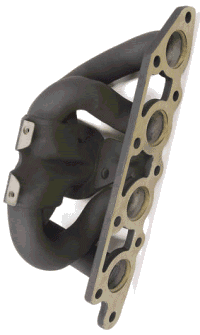 Exhaust manifolds are generally simple cast iron or stainless steel tube units which collect engine exhaust from multiple cylinders and deliver it to the exhaust pipe. Exhaust manifold consist of individual exhaust headpipes for each cylinder, which then usually converge into one tube called a collector. Headers that do not have collectors are used exclusively on race cars. The most common types of aftermarket headers are made of either ceramic, or stainless steel. Ceramic headers are lighter in weight than stainless steel, however, under extreme temperatures they can crack - something stainless steel is not prone to. The goal of performance exhaust headers is mainly to decrease flow resistance (back pressure) to right level, and to increase the volumetric efficiency of an engine, resulting in a gain in power output. Manifolds are often made of cast iron in stock production cars, and may have material-saving design features, such as to use the least metal, to occupy the least space, or have the lowest production cost. These design restrictions often result in a design that is cost effective but that does not do the most efficient job of venting the gases from the engine.
Exhaust manifolds are generally simple cast iron or stainless steel tube units which collect engine exhaust from multiple cylinders and deliver it to the exhaust pipe. Exhaust manifold consist of individual exhaust headpipes for each cylinder, which then usually converge into one tube called a collector. Headers that do not have collectors are used exclusively on race cars. The most common types of aftermarket headers are made of either ceramic, or stainless steel. Ceramic headers are lighter in weight than stainless steel, however, under extreme temperatures they can crack - something stainless steel is not prone to. The goal of performance exhaust headers is mainly to decrease flow resistance (back pressure) to right level, and to increase the volumetric efficiency of an engine, resulting in a gain in power output. Manifolds are often made of cast iron in stock production cars, and may have material-saving design features, such as to use the least metal, to occupy the least space, or have the lowest production cost. These design restrictions often result in a design that is cost effective but that does not do the most efficient job of venting the gases from the engine.
 Headers are generally made by aftermarket automotive companies. A header (sometimes called extractor in Australia) is a manifold specifically designed for performance. During header design, engineers create a manifold without regard to weight or cost but for optimal flow of the exhaust gases. This design results in a header that is more efficient at scavenging the exhaust from the cylinders.
Headers are generally made by aftermarket automotive companies. A header (sometimes called extractor in Australia) is a manifold specifically designed for performance. During header design, engineers create a manifold without regard to weight or cost but for optimal flow of the exhaust gases. This design results in a header that is more efficient at scavenging the exhaust from the cylinders.
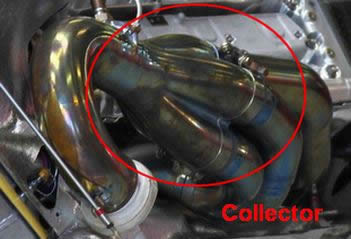
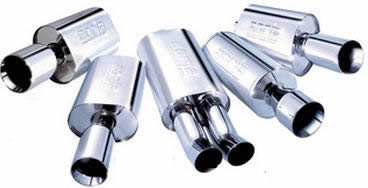 Part of road car and high performance exhaust system. If you ask exhaust designer, silencer is only pain in the ass. Silencers disturb smooth flow of gasses trough system, but is demanded by the low, I think everywhere. Job of the silencer is to reduce high sound output to reasonable level demanded by local low. Silencer is made from steel sheet, aluminized steel sheet, stainless steel or some similar material. Interior is divided in different number of small chambers connected to each other by small holes or gaps, some of chambers filled with packing or filler. Job of the filler is to further improve silencing.
Part of road car and high performance exhaust system. If you ask exhaust designer, silencer is only pain in the ass. Silencers disturb smooth flow of gasses trough system, but is demanded by the low, I think everywhere. Job of the silencer is to reduce high sound output to reasonable level demanded by local low. Silencer is made from steel sheet, aluminized steel sheet, stainless steel or some similar material. Interior is divided in different number of small chambers connected to each other by small holes or gaps, some of chambers filled with packing or filler. Job of the filler is to further improve silencing.

Today technology allow designers to target output sound frequency to desired level to suit better type of the car. System can be acoustically engineered to eliminate the specific frequencies that create drone. Using aerospace based technology, sound waves are targeted, reflected and eliminated without impeding air flow or sacrificing horsepower, yet still delivering the sound to fit your vehicle.
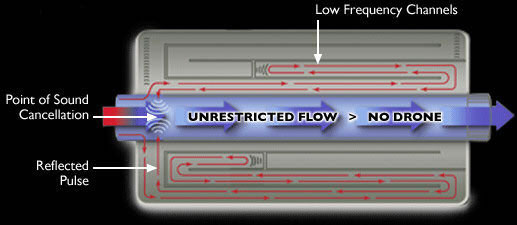
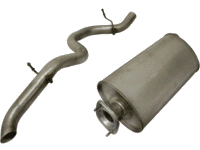 The end of the final length of exhaust pipe where it vents to open air, generally the only visible part of the exhaust system on a vehicle, often ends with just a straight or angled cut, but may include a fancy tip. The tip is sometimes chromed. It is often made of larger pipe than the rest of the exhaust system. This produces a final reduction in pressure, and sometimes used to enhance the appearance of the car.
The end of the final length of exhaust pipe where it vents to open air, generally the only visible part of the exhaust system on a vehicle, often ends with just a straight or angled cut, but may include a fancy tip. The tip is sometimes chromed. It is often made of larger pipe than the rest of the exhaust system. This produces a final reduction in pressure, and sometimes used to enhance the appearance of the car.
In the strictest technical sense, an exhaust system cannot produce more power on its own. The potential power of an engine is determined by the proper amount of fuel and oxygen available for combustion. However, the efficiency of combustion and engine pumping processes is profoundly influenced by the exhaust system. A properly designed exhaust system can reduce engine pumping losses. Therefore, the design objective for a high performance exhaust is (or should be) to reduce engine-pumping losses, and by so doing, increase volumetric efficiency. The net result of reduced pumping losses is more power available.
If you think that if you leave some exhaust gases behind in the cylinder before the next intake stroke is not important, think again. You would think that once you have maxed out on the engine's breathing ability (volumetric efficiency), the torque or power curve and volumetric efficiency would be identical. They are not. Why? Flow quality on the intake side and inefficient removal of exhaust gases out of the cylinder are what separates a winner from the car placing second in a race. The people that make that extra winning power are the ones that pay attention to ensuring that intake flow quality and cylinder exhaust gas removal are optimized, as well as working on cylinder filling (flow volume or bulk flow).
No exhaust system is ideal for all applications. At different RPMs, different sized exhaust tubes are more desirable than others. For instance, at low RPMs you would want a small diameter exhaust pipe to give some backpressure and increase low rpm torque, while at high RPMs you would want a large diameter exhaust pipe to be able to let out the exhaust gases quickly and easily, but keeping very little amount of backpressure. But it is not a direct RPM/exhaust size relationship that is only important, but it varies with manifold pressure as well. Both works together to produce exhaust pressure.
Depending on their design and purpose, all exhaust systems compromise something to achieve something else. Before manufacturing an exhaust or modifying existing stock to increase performance, it is critical to determine what kind of performance you want.
- Do you want the best possible low-end and mid-range power or maximum top-end power?
- You have to investigate the relationship between torque and horsepower
- Do you want a cosmetic exhaust system or a performance exhaust system?
Without careful thought about these variables, an exhaust system can produce very disappointing results. On the other hand, a properly designed and tuned exhaust system that is well-matched to the engine can provide outstanding power gains.
A very common mistake made by some performance people is the selection of an exhaust system with pipes that are too large in diameter for their engine's state of tune. Bigger is not necessarily better and is often worse.
As the say goes "No pain, no gain". The same argument applies to performance. The only things that are truly only bolt on a car are stuff that improves its appearance. Performance is a different story. I agree that free flow exhausts, high performance filters and stuff do improve the performance but if you need the same level of trouble free and convenient operation as a stock system, it involves a lot of work. An engine is a system, and the system has been tuned in a factory. Now the minute you and I replace a component we are changing a system. So we need to do something smart to get the system back into shape and not out of the balance. Designing a performance exhaust system is an extremely complex business that calls for an intimate knowledge of the laws of acoustics if the engineers are to tease the last reserves of power out of the engine.
One of the biggest issues with exhaust systems is the relationship between gas flow volume and gas flow velocity (which also applies to the intake track). An engine needs the highest flow velocity possible for quick throttle response and torque throughout the low-to-mid range portion of the power band. The same engine also needs the highest flow volume possible throughout the mid-to-high range portion of the power band for maximum performance. This is where a fundamental conflict arises. For "X" amount of exhaust pressure at an exhaust valve, a smaller diameter exhaust pipe will provide higher flow velocity than a larger diameter pipe. Unfortunately, the laws of physics will not allow that same small diameter pipe to flow sufficient volume to realize maximum possible power at higher RPM. If we install a larger diameter pipe, we will have enough flow volume for maximum power at mid-to-high RPM, but the flow velocity will decrease and low-to-mid range throttle response and torque will suffer. This is the primary paradox of exhaust flow dynamics and the solution is usually a design compromise that produces an acceptable amount of throttle response, torque and horsepower across the entire power band.
 When an engine starts its exhaust stroke, the piston moves up the cylinder bore, decreasing the total chamber volume. With the exhaust valve opens, the high pressure exhaust gas escapes into the exhaust manifold or header, creating an exhaust pulse. When the exhaust leaves your engine, it needs some pipe to run through. A slight bit of back pressure is required to make your motor run. It is strange but true. If there's too much back pressure, the cylinders don't scavenge enough, so the next intake doesn't get enough fuel and your power drops.
When an engine starts its exhaust stroke, the piston moves up the cylinder bore, decreasing the total chamber volume. With the exhaust valve opens, the high pressure exhaust gas escapes into the exhaust manifold or header, creating an exhaust pulse. When the exhaust leaves your engine, it needs some pipe to run through. A slight bit of back pressure is required to make your motor run. It is strange but true. If there's too much back pressure, the cylinders don't scavenge enough, so the next intake doesn't get enough fuel and your power drops.
As a matter of fact, the so-called "back pressure" isn't really pressure per se, but what's known as the "scavenging effect" and is mix of pressure and sound wave. It would take a physicist to explain it completely, but let me try with basics, here. Keep reading and see if it makes any sense!
When a car pass by you on the freeway, there's a buffeting wind behind it, because the car had a spot of low pressure behind it and this low pressure spot is trying to suck surrounding air in it. If the car passes by you and you're in a tunnel, the effect is much more pronounced. When the exhaust stroke happens, there's quite a whoosh of gasses under pressure because of rapid movement of pistons and pumping effect of it. This exhaust stroke is of a certain size and velocity at certain RPM-s, and now is moving down the exhaust pipe. This cloud too has a low-pressure spot behind it same as the car in the tunnel. Then the exhaust valve close and this creates another low-pressure wave to intensify the low-pressure spot.
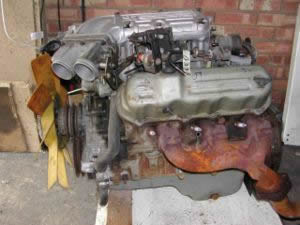 |
Left side of a Ford Cologne V6 engine, showing a cast iron exhaust manifold - three exhaust ports into one pipe. |
When this cloud exits the collector, the low pressure spot tries to suck something in behind it. And remember that engine cylinders are firing at different times. So, in an excellent exhaust system, each exhaust cloud will suck the next exhaust cloud along with it, increasing efficiency on scavenging those gasses out of there! The effect is known as scavenging. Length, cross-sectional area, and shaping of the exhaust ports and pipeworks influences the degree of scavenging effect, and the engine speed range over which scavenging occurs. If the pipe's too big, the low pressure spots are less pronounced. Then, just to make things complicated, these pressure waves develop in close-looped exhaust systems. When one cylinder fires, it sends a pressure wave down another cylinder's pipe and this affects the exhaust of that cylinder. And to add to trouble, the exhaust valve opens much sooner in the cycle to "bleed down" cylinder pressure faster so that less power goes towards the pumping loss on the upward exhaust stroke of the engine. The objective of most engine modifications is to maximize the proper air and fuel flow into, and exhaust flow out of the engine.
The inflow of an air/fuel mixture is a separate issue, but it is directly influenced by exhaust flow, particularly during valve overlap (when both valves, intake and exhaust, are open for "X" degrees of crankshaft rotation). At high revs this creates dead spots. So, the less restrictive the outlet (bigger the pipe), the less back pressure, you have better top end and your low-end power might drop off. The wrong loop in the pipe at the wrong RPM and you suffer power loss. It probably would've been simpler to say, you need some back pressure, or your motor won't run, and you can vary the back pressure for different performance. Great care must be used when selecting the length and diameter of the primary tubes. Tubes that are too large will cause the exhaust gas to expand and slow down, decreasing the scavenging effect. Tubes that are too small will create high backpressure against which the engine must work to expel the exhaust gas from the chamber, reducing power and leaving exhaust in the chamber to dilute the incoming intake charge. Since engines produce more exhaust gas at higher speeds, the header(s) are tuned to a particular engine speed range according to the intended application. Typically, wide primary tubes offer the best gains in power and torque at higher engine speeds, while narrow tubes offer the best gains in power and torque at lower speeds.
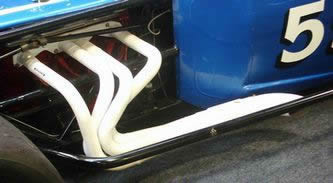 |
Ceramic exhaust coating on performance car |
Many headers are also resonance tuned, to utilize the low-pressure reflected wave rarefaction pulse which can help scavenging the combustion chamber during valve overlap. This pulse is created in all exhaust systems each time a change in density occurs, such as when exhaust merges into the collector. By tuning the length of the primary tubes, usually by means of resonance tuning, the rarefaction pulse can be timed to coincide with the exact moment valve overlap occurs. Typically, long primary tubes resonate at a lower engine speed than short primary tubes.
The magnitude of the exhaust scavenging effect is a direct function of the velocity of the high and medium pressure components of the exhaust pulse. Performance headers work to increase the exhaust velocity as much as possible. One technique is tuned-length primary tubes. This technique, used in Formula 1, attempts to time the each exhaust pulse, to occur one after the other in succession while still in the exhaust system. The lower pressure tail of an exhaust pulse then serves to create a greater pressure difference between the high pressure head of the next exhaust pulse, thus increasing the velocity of that exhaust pulse. In V6 and V8 engines where there is more than one exhaust bank, Y-pipes and X-pipes work on the same principle of using the low pressure component of an exhaust pulse to increase the velocity of the next exhaust pulse.
Much controversy (and apparent confusion) surrounds the issue of exhaust "back-pressure". Many performance-minded people who are otherwise knowledgeable still cling tenaciously to the old school concept.... "You need more back-pressure for better performance."
For virtually all high performance purposes, to high back-pressure in an exhaust system increases engine-pumping losses and decreases available engine power. It is true that some engines are mechanically tuned to some amount of backpressure and can show a loss of low-end torque when that backpressure is reduced. It is also true that the same engine that lost low-end torque with reduced back-pressure can be mechanically re-tuned to show an increase of low-end torque with the same reduction of back-pressure. More importantly, maximum mid-to-high RPM power will be achieved with the lowest possible backpressure. Lowest possible, but not without.

Assuming that an exhaust system is otherwise properly designed, equal length pipes offer some benefits that are not present with unequal length pipes. These benefits are smoother engine operation, tuning simplicity and increased low-to-mid range torque. Strangely enough, Formula 1 engine use equal length pipes, but with increased mid to high range torque.
If the pipes are not equal length, both inertial scavenging and wave (resonance) scavenging will vary among engine cylinders, often dramatically. This, in turn, causes different tuning requirements for different cylinders. These variations affect air/fuel mixtures and timing requirements, and can make it very difficult to achieve optimal tuning. Equal length pipes eliminate these exhaust-induced difficulties. "Tuning", in the context used here, does not mean installing new sparkplugs and an air filter. It means configuring a combination of mechanical components to maximum efficiency for a specific purpose and it can not be overemphasized that such tuning is the path to superior performance with a combination of parts that must work together in a complimentary manner.
In an exhaust system that is properly designed for its application, equal length pipes are generally more efficient. The lengths of both the primary and main section of pipes strongly influence the location of the torque peak(s) within the power band. In street and track performance engines with longer pipes typically produce more low-to-mid range torque than shorter pipes and it is torque that moves a car. The question is... Where in the power band do you want to maximize the torque?
Longer pipes tend to increase power below the engine’s torque peak and shorter pipes tend to increase power above the torque peak.
Large diameter pipes tend to limit low-range power and increase high range power.
Small diameter pipes tend to increase low-range power and to some degree limit high-range power.
"Balance" or "equalizer" chambers between the exhaust pipes tend to flatten the torque peak(s) and widen the power band.
Inertial scavenging and wave scavenging are different phenomena but both impact exhaust system efficiency and affect one another. These two scavenging effects are directly influenced by pipe diameter, length, shape and the thermal properties of the pipe material (stainless, mild steel, thermal coatings, ceramics etc.). When the exhaust valve opens, two things immediately happen. An energy wave, or pulse, is created from the rapidly expanding combustion gases. The wave enters the exhaust pipe traveling outward at a nominal speed of 1,400 – 2,000 km/h (1,300 - 1,700 feet per second) (this speed varies depending on engine design, modifications, etc., and is therefore stated as a "nominal" velocity). This wave is pure energy, similar to a shock wave from an explosion. Simultaneous with the energy wave, the spent combustion gases also enter the exhaust pipe and travel outward more slowly at 150 - 300 km/h nominal (maximum power is usually made with gas velocities between 250 and 350 km/h). Since the energy wave is moving about 5 times faster than the exhaust gases, it will get where it is going faster than the gases. When the outbound energy wave encounters a lower pressure area such as a second or larger diameter section of pipe, the muffler or the ambient atmosphere, a reversion wave (a reversed or mirrored wave) is reflected back toward the exhaust valve without significant loss of velocity.
The reversion wave moves back toward the exhaust valve on a collision course with the exiting gases whereupon they pass through one another, with some energy loss and turbulence, and continue in their respective directions. What happens when that reversion wave arrives at the exhaust valve depends on whether the valve is still open or closed. This is a critical moment in the exhaust cycle because the reversion wave can be beneficial or detrimental to exhaust flow, depending upon its arrival time at the exhaust valve. If the exhaust valve is closed when the reversion wave arrives, the wave is again reflected toward the exhaust outlet and eventually dissipates its energy in this back and forth motion. If the exhaust valve is open when the wave arrives, its effect upon exhaust gas flow depends on which part of the wave is hitting the open exhaust valve. An exhaust pipe of the proper length (for a specific RPM range) will place the wave’s anti-node at the exhaust valve at the proper time for it’s lower pressure to help fill the combustion chamber with fresh incoming charge and to extract spent gases from the chamber. This is wave scavenging or "wave tuning".
There are other factors that further complicate the behavior of exhaust gases. Wave harmonics, wave amplification and wave cancellation effects also play into the scheme of exhaust events. The interaction of all these variables is so abstractly complex that it is difficult to fully grasp. There does not appear to be any absolute formula that will produce the perfect exhaust design. Even super-computer designed exhaust systems must undergo dyno, track, and street testing to determine the necessary configuration for the desired results. Last but not least, the correct choices and combinations of carburetor, air cleaner, cam shaft, ignition, and exhaust used in the proper relationship to each other for the intended driving application will always produce the finest quality results. Most important of all, is to do your research prior to purchasing the combination of products and equipment best suited to your individual style of driving.

Today's understanding of exhaust systems and fluid dynamics has given rise to a number of mechanical improvements. Some very smart people in motorcycle racing at Yamaha developed an ingenious device called an exhaust throttle valve (actually Yamaha called theirs an EXUP valve and were the first to use this idea; Honda called theirs the H-VIX valve). These valves are placed at the merge points of the header primaries. They are kept open and are continuous with the header. At cam overlap, the valve partially closes. This prevents both the intake air-fuel mix from shooting into the header (called overscavenging) and blocks any reflected exhaust wave from arriving back to the combustion chamber. When cam overlap is over, the valve re-opens. So there is a brief increase in backpressure at cam overlap only with the exhaust throttle valve and nowhere else along the engine cycle. The valve is activated and then disabled by the ECU which measures ignition timing to determine when cam overlap occurs and the potentiometer to determine the position or angle of the throttle valve itself. It constantly adjusts the back pressure within the collector of the exhaust system to enhance pressure wave formation as a function of engine speed. This ensures good low to mid-range performance.
More supercars now employ variable back-pressure exhaust. It is somewhat like the variable intake manifold, just locate at the exhaust. Normal exhaust pipes for sports cars collect exhaust pulse from individual cylinders and combine them to a larger pulse, with a corresponding lower pressure behind the pulse. This low pressure actually helps drawing more air / fuel mixture into the cylinder from intake manifolds. This is also called "reverse supercharging".
The reverse supercharging work best at a certain engine RPM-s which is determined by the length and size of the exhaust pipe. The shorter the pipe, the lower rpm the reverse supercharging works. Of course, for any fixed exhaust pipes, the choose of working RPM is always a compromise.
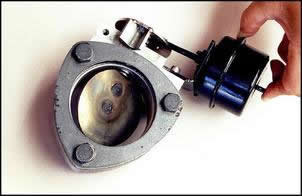 Heart of Variable back-pressure exhaust usually is a variable opening valve that is fitted as part a vehicle’s exhaust system. The butterfly or ball valve opening is infinitely variable over a 90 degree range and is designed to control exhaust noise and backpressure. The valve is typically used to reduce noise where a big-bore aftermarket exhaust is fitted. Variable back-pressure exhaust usually provides 2 different lengths of exhaust pipes. The switching between them is via opening and closing of valves. Therefore it satisfies both the requirements of high speed and low speed output. Moreover, it helps complying EU’s noise regulations, which set upper limits according to speed.
Heart of Variable back-pressure exhaust usually is a variable opening valve that is fitted as part a vehicle’s exhaust system. The butterfly or ball valve opening is infinitely variable over a 90 degree range and is designed to control exhaust noise and backpressure. The valve is typically used to reduce noise where a big-bore aftermarket exhaust is fitted. Variable back-pressure exhaust usually provides 2 different lengths of exhaust pipes. The switching between them is via opening and closing of valves. Therefore it satisfies both the requirements of high speed and low speed output. Moreover, it helps complying EU’s noise regulations, which set upper limits according to speed.
An advantage of this system is optimizing high and low speed output and reduces noise at low speed. Some big names in high performance cars using it, likes of Aston Martin Vanquish, Ferrari 550 Maranello, 360 Modena, Honda Integra Type R, Lamborghini Diablo 6.0 and some other high performance cars.
When the butterfly valve is closed – or very near closed – it improves noise suppression of mufflers and cat converters. The valve itself also has a quietening effect. However, when the valve is open, it sacrifices its noise suppression advantage to allow maximum engine breathing and power.
Put simply, the active exhaust valve provides the best of both worlds – noise suppression and maximum exhaust flow when you want it.
Control over butterfly valve angle is critical. At any given moment, the valve angle must provide the suitable balance of noise suppression and engine performance. Typically, the valve is near closed at idle, cruise and part throttle – this gives a quiet exhaust in all normal driving conditions. However, at wide open throttle, the valve should be fully open for maximum performance.
Around 1970 Pontiac offered a vacuum-powered manually controlled variable exhaust on the GTO. This was a very rare and little known option.
Just one more way the new 2010 Prius improves on efficiency... the new 2010 Prius muffler too has a spring loaded bypass valve to improve performance at various speeds.

For low power operation, the valve flap remains closed guiding exhaust gases through an additional chamber for quieter operation. However, during mid to higher power (flow) operation, the valve progressively opens to bypass one of the chambers for substantially lower back pressure and improved performance.
To learn more about how camshaft operating poppet valves check my article here.
To learn more about Formula 1 pneumatic valve actuation check my article here.






